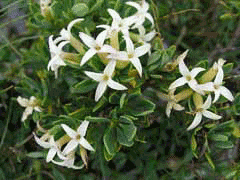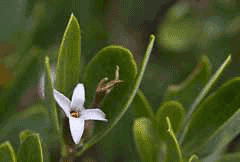 |
|
http://flickr.com/photos/nturland/ |
 |
| http://flickr.com/photos/31899925%40N08 |
Translate this page:
Summary
Physical Characteristics

 Daphne oleoides is an evergreen Shrub growing to 1 m (3ft 3in).
Daphne oleoides is an evergreen Shrub growing to 1 m (3ft 3in).
See above for USDA hardiness. It is hardy to UK zone 8. It is in leaf all year, in flower from May to June. The species is hermaphrodite (has both male and female organs) and is pollinated by Bees, flies, Lepidoptera (Moths & Butterflies).
Suitable for: medium (loamy) and heavy (clay) soils and prefers well-drained soil. Suitable pH: mildly acid and neutral soils. It cannot grow in the shade. It prefers dry or moist soil.
UK Hardiness Map
US Hardiness Map
Synonyms
D. buxifolia. Sibth.&Smith. D. glandulosa. D. jasminea. non Sibth.&Smith. D. lucida.
Plant Habitats
Cultivated Beds;
Edible Uses
There is a report that the fruit is eaten, but this report then goes on to say that they cause nausea and vomiting[2]. There is also a report that they can be distilled to make an alcoholic drink[2].
References More on Edible Uses
Medicinal Uses
Plants For A Future can not take any responsibility for any adverse effects from the use of plants. Always seek advice from a professional before using a plant medicinally.
Purgative Skin VD
The roots are purgative[46, 61, 240]. An infusion of the bark and leaves are used in the treatment of cutaneous affections[240]. The leaves are also used in the treatment of gonorrhoea and are applied to abscesses[240].
References More on Medicinal Uses
The Bookshop: Edible Plant Books
Our Latest books on Perennial Plants For Food Forests and Permaculture Gardens in paperback or digital formats.

Edible Tropical Plants
Food Forest Plants for Hotter Conditions: 250+ Plants For Tropical Food Forests & Permaculture Gardens.
More

Edible Temperate Plants
Plants for Your Food Forest: 500 Plants for Temperate Food Forests & Permaculture Gardens.
More

More Books
PFAF have eight books available in paperback and digital formats. Browse the shop for more information.
Shop Now
Other Uses
References More on Other Uses
Cultivation details
Prefers a cool lime-free well-drained friable soil[1]. Plants are usually calcicole and require an acid soil[50]. Survives in any well-fed and well-drained soil in sun or part shade according to one report which also says that it is a reliable plant in most parts of the country[182]. This species is not very hardy outside the mildest areas of Britain, tolerating temperatures down to about -5°c[200]. Plants are resentful of root disturbance and should be planted into their permanent positions as soon as possible[188]. The flowers have a clove-like perfume[245].
References Carbon Farming Information and Carbon Sequestration Information
Temperature Converter
Type a value in the Celsius field to convert the value to Fahrenheit:
Fahrenheit:
The PFAF Bookshop
Plants For A Future have a number of books available in paperback and digital form. Book titles include Edible Plants, Edible Perennials, Edible Trees,Edible Shrubs, Woodland Gardening, and Temperate Food Forest Plants. Our new book is Food Forest Plants For Hotter Conditions (Tropical and Sub-Tropical).
Shop Now
Plant Propagation
Seed - best sown in a greenhouse as soon as it is ripe with the pot sealed in a polythene bag to hold in the moisture. Remove this bag as soon as germination takes place[164]. The seed usually germinates better if it is harvested 'green' (when it has fully developed but before it dries on the plant) and sown immediately. Germination should normally take place by spring, though it sometimes takes a further year. Stored seed is more problematic. It should be warm stratified for 8 - 12 weeks at 20°c followed by 12 - 14 weeks at 3°c. Germination may still take another 12 months or more at 15°c[164]. Prick out the seedlings into individual pots as soon as they are large enough to handle. Grow the plants on in the greenhouse for their first winter and then plant out in spring after the last expected frosts. Cuttings of half-ripe wood, July/August in a frame.
Other Names
If available other names are mentioned here
Native Range
TEMPERATE ASIA: Lebanon, Syria, Turkey, Armenia, Azerbaijan, Georgia EUROPE: Albania, Bulgaria, Greece, Italy, North Macedonia, Montenegro, Serbia (Kosovo, Vojvodina), Spain, France AFRICA: Algeria
Weed Potential
Right plant wrong place. We are currently updating this section.
Please note that a plant may be invasive in one area but may not in your area so it's worth checking.
Conservation Status
IUCN Red List of Threatened Plants Status :

Growth: S = slow M = medium F = fast. Soil: L = light (sandy) M = medium H = heavy (clay). pH: A = acid N = neutral B = basic (alkaline). Shade: F = full shade S = semi-shade N = no shade. Moisture: D = dry M = Moist We = wet Wa = water.
Now available:
Food Forest Plants for Mediterranean Conditions
350+ Perennial Plants For Mediterranean and Drier Food Forests and Permaculture Gardens.
[Paperback and eBook]
This is the third in Plants For A Future's series of plant guides for food forests tailored to
specific climate zones. Following volumes on temperate and tropical ecosystems, this book focuses
on species suited to Mediterranean conditions—regions with hot, dry summers and cool, wet winters,
often facing the added challenge of climate change.
Read More
Expert comment
Author
Schreb.
Botanical References
1150200
Links / References
For a list of references used on this page please go here
Readers comment
| Add a comment |
|
If you have important information about this plant that may help other users please add a comment or link below. Only comments or links that are felt to be directly relevant to a plant will be included. If you think a comment/link or information contained on this page is inaccurate or misleading we would welcome your feedback at [email protected]. If you have questions about a plant please use the Forum on this website as we do not have the resources to answer questions ourselves.
* Please note: the comments by website users are not necessarily those held by PFAF and may give misleading or inaccurate information.
To leave a comment please Register or login here All comments need to be approved so will not appear immediately.
|
Subject : Daphne oleoides
|
|
|
|